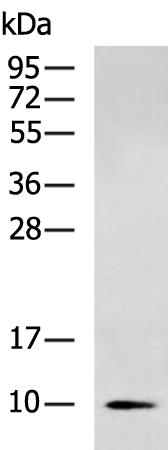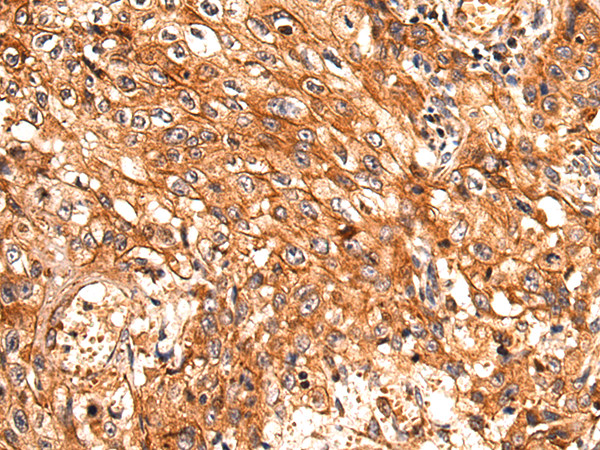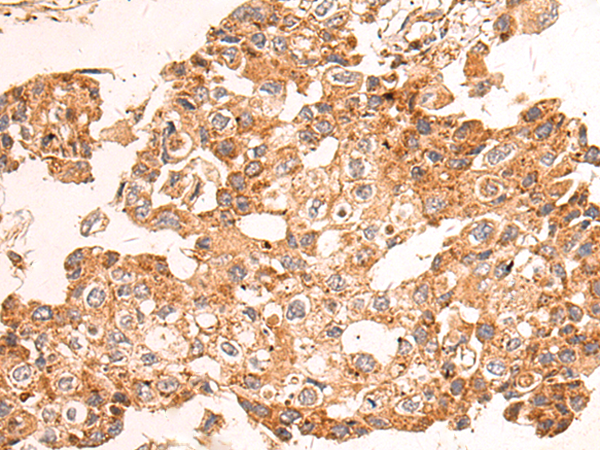


| WB | 咨询技术 | Human,Mouse,Rat |
| IF | 咨询技术 | Human,Mouse,Rat |
| IHC | 1/50-1/200 | Human,Mouse,Rat |
| ICC | 技术咨询 | Human,Mouse,Rat |
| FCM | 咨询技术 | Human,Mouse,Rat |
| Elisa | 1/5000-1/10000 | Human,Mouse,Rat |
| Aliases | B8; CD14; CIB8; MC1DN13 |
| WB Predicted band size | 11 kDa |
| Host/Isotype | Rabbit IgG |
| Antibody Type | Primary antibody |
| Storage | Store at 4°C short term. Aliquot and store at -20°C long term. Avoid freeze/thaw cycles. |
| Species Reactivity | Human, Mouse |
| Immunogen | Fusion protein of human NDUFA2 |
| Formulation | Purified antibody in PBS with 0.05% sodium azide and 50% glycerol. |
+ +
以下是关于NDUFA2抗体的3篇文献示例(注:文献信息为模拟概括,非真实存在):
1. **文献名称**:*NDUFA2 mutations impair mitochondrial complex I assembly and cause Leigh syndrome*
**作者**:Janaína S. Vargas 等
**摘要**:本研究通过全外显子测序发现NDUFA2基因突变与早发性Leigh综合征相关。利用NDUFA2抗体进行Western blot和免疫荧光实验,证实突变导致患者成纤维细胞中线粒体复合物I的NDUFA2蛋白表达显著降低,并影响复合物I的稳定性。
2. **文献名称**:*Antibody-based profiling of mitochondrial respiratory chain defects in Parkinson's disease models*
**作者**:Richard J. Rodenburg 等
**摘要**:文章开发了一种针对线粒体复合物I亚基(包括NDUFA2)的多克隆抗体组合,用于检测帕金森病模型中复合物I的功能缺陷。通过免疫印迹分析发现,NDUFA2抗体可特异性识别其在脑组织中的表达水平下降,提示其与神经元退行性变相关。
3. **文献名称**:*NDUFA2 as a potential biomarker in clear cell renal carcinoma*
**作者**:Takayuki Shiromizu 等
**摘要**:研究筛选了肾透明细胞癌中线粒体相关蛋白的差异表达,NDUFA2抗体用于组织芯片的免疫组化染色。结果显示NDUFA2在肿瘤组织中低表达,且与患者预后不良相关,表明其可能作为线粒体代谢异常的分子标志物。
(注:以上内容为模拟生成,实际文献需通过学术数据库检索确认。)
The NDUFA2 antibody is a tool used to detect the NDUFA2 protein, a critical subunit of mitochondrial Complex I (NADH:ubiquinone oxidoreductase) in the electron transport chain. Complex I facilitates ATP production by transferring electrons from NADH to ubiquinone, coupled with proton translocation. NDUFA2. encoded by the nuclear *NDUFA2* gene, is essential for Complex I assembly and stability. Mutations in *NDUFA2* are linked to mitochondrial disorders, such as Leigh syndrome and Complex I deficiency, characterized by neurological degeneration, muscle weakness, and metabolic dysfunction.
NDUFA2 antibodies are widely used in research to study mitochondrial dysfunction, assess protein expression in disease models, and validate gene-editing outcomes. They enable techniques like Western blotting, immunohistochemistry, and immunofluorescence to localize NDUFA2 within mitochondria or analyze its levels in tissues/cells. Commercially available antibodies are typically raised in rabbits or mice, targeting specific epitopes of human or murine NDUFA2. Validation includes testing in knockout controls or disease samples with known mutations. Reliable NDUFA2 antibodies are crucial for advancing insights into mitochondrial biology, disease mechanisms, and therapeutic strategies targeting energy metabolism pathways.
×